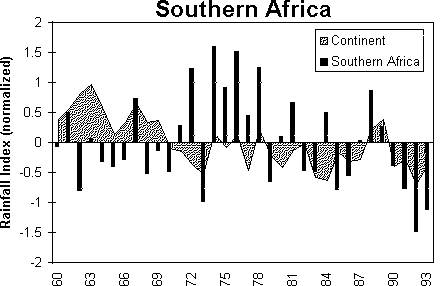|
|
 |
|
|
|
 |
| |
|
|
 |
Food & Climate
Read more |
Present realities and future uncertainties
Even though there are still many unknowns, the climate change issue has emerged as the major environmental challenge of our time. We now know that current and future levels of fossil fuel combustion for energy production and forest clearing for cultivation have profound effects on our global environment and on key economic sectors.
We need to understand the impacts of global warming today so we can manage future development wisely.
|
|
|
|
|
 |
 |
 |
|
1. People in Africa.
|
|
 |
The consequences of disastrous climatic events are regularly seen in the Media. Famines caused by droughts or torrential rains and the amounts of money spent on international relief efforts to prevent them, are a concern to all of us.
|
|
Just about everyone realises that food production is linked to weather and climate. In 1987, weak monsoon rains in India and Pakistan were responsible for low crop yields and forced these countries import wheat to feed their people. The 1980's also saw the continuing deterioration of food production in Africa, caused in part by persistent drought. The 1991-1992 drought in southern Africa is generally regarded as the worst drought of the century. It affected nearly 100 million people living in the 10 Southern African Development Community estates and 11.6 million tonnes of drought related commodities had to be imported into the region over 13 month period.
|
 |
 |
|
2. This graph shows how rainfall varied over South Africa between 1960 and 1993. There was a great decrease in rainfall amounts between 1990 and 1992. From Sustainable Development Department, FAO.
|
|
If the build-up of carbon dioxide and other greenhouse gases in the atmosphere continues without limit, the surface of the Earth is bound to warm up. Such a warming trend must affect water supply, agriculture, and food production. The impact of future warming is uncertain at present. However scientists point out that, although computer models which predict the future are full of uncertainties, the effects of climate change are not unpredictable. The uncertainties argue in favour of further research and knowing the benefits and disadvantages of alternative responses to global warming are crucial, even if they are far from perfect.
|
Predicting the future leads to great uncertainties:
- What will future levels of carbon dioxide be?
- How much warming will occur?
- When will this warming occur and at what rate?
- Which geographical regions and seasons will be most affected?
- What are the likely consequences for agricultural productivity in different countries and regions?
- Will some areas benefit while other areas suffer, and who might the winners and losers be?
- What can be done to mitigate these changes?
- What can be done to adapt our practices to minimize or overcome the impacts of climate change?
|
About this page:
Author: Marta Moneo and Dr. Ana Iglesias - Universidad Politécnica de Madrid, España
1. scientific reviewer: Alex de Sherbinin - CIESIN, Columbia University, USA
2. scientific reviewer: Lily Parshall - Goddard Institute for Space Studies, Columbia University, USA
educational reviewer: Emilio Sternfeld - Colegio Virgen de Mirasierra - España
last published: 2004-05-12
|
|
 |
|







